How to Train Clients With Heart Disease (Step-by-Step Guide)
Knowing how to train clients with heart disease can provide a meaningful expansion to your personal training services. However, it’s crucial to have the appropriate tools and knowledge to effectively train these clients. Using specific features of personal training software can assist in achieving this goal. Discover how to train clients with heart disease and all the best personal training tools in this comprehensive guide.
- Training clients with heart disease requires a carefully balanced approach that includes both cardiovascular and strength training to help manage their heart health and overall fitness.
- Most clients with heart disease will need a monitored exercise routine that helps control weight, manage blood pressure, and enhance cardiovascular health, without putting undue stress on the heart.
- Implementing workout and assessment software can help secure your client’s safety while assisting them in reaching their fitness goals with fewer complications.
Training special populations, like clients with heart disease, can provide personal trainers a rewarding way to diversify their fitness business.
To effectively train clients with heart disease, it’s crucial to not only understand the condition but also have the necessary tools to facilitate effective and safe training; that’s where personal training software becomes invaluable. By using the features offered by the best online personal training software, you can train clients with heart disease in a way that supports their heart health and overall wellness.

For a firsthand experience of the leading personal training software from Exercise.com, book a demo now!
Table of Contents
Understanding Heart Disease and Exercise
Heart disease is a prevalent and serious condition that affects millions of individuals worldwide. As a fitness professional, it is essential to understand the intricacies of heart disease and how exercise can play a crucial role in managing and improving cardiovascular health. In this comprehensive guide, we will delve into the various aspects of training clients with heart disease, including understanding the condition, assessing fitness levels, creating safe and effective exercise plans, and collaborating with medical professionals for optimal results.
Before delving into the training protocols, it is crucial to have a solid understanding of heart disease and its implications for exercise. Heart disease, also known as cardiovascular disease, encompasses various conditions that affect the heart and blood vessels. These conditions include coronary artery disease, heart failure, arrhythmias, and valvular heart diseases. Each condition presents unique challenges and considerations when designing exercise programs for clients.
Exercise plays a pivotal role in managing heart disease by reducing the risk of cardiovascular events, improving overall cardiovascular health, and enhancing overall quality of life. However, it is essential to tailor exercise programs to individual needs, limitations, and medical recommendations. By customizing workouts, fitness professionals can maximize benefits and minimize potential risks associated with exercise.
The Importance of Exercise for Clients with Heart Disease
Regular exercise has transformative effects on individuals with heart disease. It helps to improve cardiac function, enhance blood flow, reduce blood pressure, lower LDL cholesterol levels, increase HDL cholesterol levels, promote weight management, enhance insulin sensitivity, and enhance overall mood and well-being.
Furthermore, exercise has been proven to reduce the risk of heart attack, stroke, and other complications associated with heart disease. It also helps to alleviate symptoms such as shortness of breath, fatigue, and chest pain, enabling individuals to perform daily activities more comfortably and enjoy an improved quality of life.
When developing exercise plans for clients with heart disease, a balance between cardiovascular exercise, strength training, flexibility exercises, and adequate rest and recovery periods is crucial. A multi-faceted approach addresses cardiovascular health, muscular strength, flexibility, and proper alignment, leading to overall improved fitness and cardiac well-being.
Assessing the Fitness Level of Clients with Heart Disease
Before initiating any exercise program, a comprehensive fitness assessment is imperative to determine the client’s baseline fitness level and identify any specific considerations associated with their heart condition.
Start by conducting a thorough health history interview, which includes questions about the client’s medical history, medications, symptoms experienced during exercise or physical activity, previous cardiac events, and any previous exercise training or physical therapy.
Assessing resting heart rate, blood pressure, body composition, flexibility, muscular strength, and endurance are also essential components of the fitness assessment process. These measurements provide valuable information that will guide exercise prescription and ensure safety throughout the training program.
Creating a Safe and Effective Exercise Plan for Clients with Heart Disease
Designing a safe and effective exercise plan for clients with heart disease requires careful consideration of their current fitness level, medical recommendations, and individual goals. Collaborating with their healthcare providers is crucial to ensure that the exercise plan aligns with their medical condition and limitations.
Begin by selecting appropriate cardiovascular exercises based on the client’s tolerance, preferences, and guidelines provided by their healthcare team. Low-impact activities such as walking, cycling, swimming, and using elliptical machines are often recommended due to their lower risk of joint impact and injury.
Gradually progress exercise intensity, duration, and frequency based on the client’s tolerance and response to training. Monitoring heart rate and blood pressure during exercise sessions is crucial to ensure that the exercise intensity remains within a safe and manageable range.
Incorporating strength training exercises into the exercise plan is also essential for clients with heart disease. Focus on exercises that target major muscle groups, utilizing resistance that allows for 12-15 repetitions per set. Ensure proper form, breathing techniques, and encourage clients to work at a level that challenges their muscles without overexertion.
Choosing the Right Types of Exercise for Clients with Heart Disease
Selecting the right types of exercise for clients with heart disease depends on their specific condition, fitness level, and preferences. A combination of cardiovascular exercises, strength training, flexibility exercises, and relaxation techniques should be integrated into the training program to target various aspects of cardiovascular fitness and overall well-being.
Aerobic exercises such as walking, jogging, cycling, swimming, and dancing help to improve cardiovascular endurance and strengthen the heart muscle. These activities should be performed at a moderate intensity, allowing clients to maintain a conversation without excessive strain.
Strength training exercises should focus on major muscle groups, utilizing resistance that challenges the muscles without compromising safety and joint integrity. Flexibility exercises such as stretching and yoga help to maintain or improve joint range of motion, reduce muscle tightness, and alleviate stress.
Furthermore, incorporating relaxation techniques, such as deep breathing exercises, meditation, and guided visualization, can aid in stress reduction and improve overall cardiovascular health.
Tailoring Workouts to Individual Needs and Limitations
Every client with heart disease possesses unique needs, limitations, and goals, which necessitate a customized training program. Considerations such as age, fitness level, medical recommendations, lifestyle, work schedule, and access to equipment must be carefully taken into account when tailoring workouts.
For clients with limited mobility or joint issues, low-impact exercises that are gentle on the joints, such as water aerobics or chair-based exercises, can be incorporated. Utilizing modifications and adaptations for exercises allows clients to participate in physical activity while minimizing the risk of discomfort or injury.
Additionally, paying attention to individual preferences and providing options and alternatives is crucial for maintaining motivation and adherence. Making exercise enjoyable and varied assists clients in staying committed to their fitness goals and embracing physical activity as a long-term lifestyle change.
Monitoring Heart Rate and Blood Pressure During Exercise Sessions
Regular monitoring of heart rate and blood pressure during exercise sessions is a crucial aspect of training clients with heart disease. It allows for the assessment of exercise intensity and adherence to safe and appropriate levels of effort.
Heart rate monitors are valuable tools for tracking exercise intensity. The target heart rate range for clients with heart disease generally falls between 50-70% of their maximum heart rate, as determined by their medical professionals.
During exercise sessions, ensure that blood pressure remains within a safe range. Clients should be educated about signs and symptoms of exertion and encouraged to report any discomfort or unusual sensations. Modifying exercise intensity or duration may sometimes be necessary to maintain safe levels of exertion and avoid potential complications.
Incorporating Cardiac Rehabilitation Techniques into Training Programs
Cardiac rehabilitation techniques, which are designed to improve cardiovascular health, stamina, and quality of life, can be incorporated into training programs for clients with heart disease. These techniques focus on gradually increasing exercise intensity and duration while monitoring vital signs and symptoms.
Phase-based exercise programming, following the guidelines established by cardiac rehabilitation, can provide a structured approach to gradually build endurance, strength, and cardiovascular fitness. The progression is typically divided into phases, each with specific goals and recommendations. Progression to the next phase is based on the client’s physiological response, medical professional approval, and overall readiness for increased intensity or workload.
A collaborative approach with a cardiac rehabilitation specialist or medical professional can ensure that the exercise program aligns with prescribed guidelines and optimizes the client’s progress and recovery.
Using Modified Strength Training Exercises for Clients with Heart Disease
Strength training exercises provide numerous benefits for clients with heart disease. However, modifications may be necessary to accommodate specific limitations or considerations associated with their condition.
For clients with unstable angina or recent heart procedures, exercises that require excessive straining or valsalva maneuver should be avoided. Additionally, clients with heart failure may require lower intensities and higher repetitions during strength training exercises.
Implementing exercises that provide postural support, such as seated or supine variations of traditional exercises, may be beneficial for clients with balance issues or orthopedic concerns. Emphasizing proper breathing techniques, maintaining smooth and controlled movements, and practicing proper form is vital to prevent unnecessary strain or injury.
Implementing Cardiovascular Conditioning Techniques Safely
Conditioning exercises aim to improve cardiovascular endurance and overall cardiovascular fitness. However, it is essential to implement these techniques safely, especially for clients with heart disease.
A gradual approach to increasing exercise intensity and duration is crucial. Start with low-impact activities such as walking or cycling, gradually increasing the duration and intensity as the client’s tolerance improves.
Interval training, where periods of higher intensity are alternated with active recovery, can be an effective way to improve cardiovascular fitness without placing excessive strain on the heart. Monitoring heart rate and symptoms during intervals allows for adjustments to ensure safety and proper cardiovascular response to training.
Encourage clients to listen to their bodies and communicate any discomfort or signs of overexertion. Modify the exercise plan accordingly to optimize safety and progress gradually.
Teaching Proper Breathing Techniques for Optimal Cardiac Health
Breathing techniques play a significant role in managing heart disease and optimizing cardiac health. Ensuring that clients with heart disease understand and practice proper breathing techniques during exercise is essential.
Teach clients to engage in diaphragmatic breathing, also known as belly breathing. This technique helps slow down breathing, reduces perceived exertion, and promotes relaxation. Instruct clients to inhale deeply through the nose, allowing their abdomen to rise, and exhale slowly through pursed lips, allowing the abdomen to fall.
Proper breathing techniques assist in maintaining optimal oxygenation, reducing the strain on the heart, and promoting a more controlled and efficient exercise experience.
Building Endurance and Stamina Gradually for Cardiac Fitness
Building endurance and stamina is a vital aspect of training clients with heart disease. However, progression should be gradual and personalized to each client’s capabilities, medical recommendations, and overall health status.
Focus on gradually increasing exercise duration, intensity, and frequency over time. Ensure an appropriate balance between challenging the cardiovascular system and allowing for adequate rest and recovery.
Implementing periodization principles, where exercise intensity and volume are systematically varied, can assist in optimizing cardiovascular fitness without overly taxing the body. This approach incorporates periods of progression and recovery to prevent overtraining and enhance adaptation.
Balancing Cardiovascular Exercise with Rest and Recovery Periods
Rest and recovery are essential elements of any exercise program, especially for clients with heart disease. Balancing cardiovascular exercise with appropriate rest intervals allows for recovery and adaptation while minimizing the risk of overexertion.
Recommend incorporating regular rest days into the training week, with a focus on active recovery such as gentle stretching, deep breathing exercises, or light mobility work.
Encourage clients to listen to their bodies, allowing for additional rest and recovery when necessary. Educate them about the importance of quality sleep as it plays a vital role in overall cardiovascular health, recovery, and stress management.
Educating Clients about the Importance of Lifestyle Changes in Managing Heart Disease
Exercise is just one component of managing heart disease. It is crucial to educate clients about the significance of lifestyle changes in maximizing their overall health and well-being.
Discuss the importance of healthy eating habits, maintaining a balanced diet, reducing sodium and saturated fat intake, incorporating fruits, vegetables, whole grains, and lean proteins into their meals, and monitoring portion sizes.
Emphasize the benefits of smoking cessation, managing stress, and avoiding or moderating alcohol consumption. Encourage clients to prioritize regular medical check-ups and adhere to prescribed medications or treatments.
Promoting Stress Reduction Techniques as Part of a Comprehensive Training Plan
Stress management plays a crucial role in cardiovascular health. Chronic stress can contribute to the development and progression of heart disease. As such, incorporating stress reduction techniques into the training plan is highly beneficial for clients with heart disease.
Encourage clients to explore activities that promote relaxation and reduce stress, such as mindfulness meditation, yoga, tai chi, or engaging in hobbies and leisure activities. These techniques can assist in managing stress levels, promoting better sleep, and facilitating overall cardiovascular wellness.
Addressing Common Concerns and Fears Related to Exercising with Heart Disease
Many individuals with heart disease have concerns and fears related to exercising. As a fitness professional, addressing these concerns is vital to establish trust and ensure clients feel confident and safe during their training sessions.
Address common fears such as fear of experiencing another cardiac event during exercise, fear of not being able to keep up with the program or feeling embarrassed, and fear of experiencing pain or discomfort. Provide clear and transparent communication about the safety precautions in place, the importance of starting slowly, and emphasizing the individualized nature of the exercise plan.
Collaborating with Medical Professionals to Ensure Safe Exercise Programming for Clients with Heart Disease
Collaborating with medical professionals is fundamental in designing exercise programs for individuals with heart disease. Engaging in open communication and obtaining medical clearances or guidelines is crucial to ensure safety and optimize results.
Provide progress updates to the client’s healthcare team and seek guidance when necessary. A collaborative approach that includes regular communication and a shared understanding of the client’s health status contributes to their overall well-being and success in managing heart disease.
Recognizing Warning Signs or Symptoms during Exercise Sessions
While exercise is generally safe and beneficial for clients with heart disease, it is essential to recognize warning signs or symptoms that may indicate potential complications.
Instruct clients on the importance of listening to their bodies and promptly reporting any unusual symptoms during or after exercise. These symptoms may include chest pain or discomfort, shortness of breath, dizziness or lightheadedness, excessive fatigue, or excessive sweating.
If any of these symptoms occur, instruct the client to stop exercising and seek medical attention if necessary. Adjusting the exercise plan and seeking guidance from healthcare professionals may be necessary to prevent further complications.
Providing Ongoing Support and Motivation to Clients Living with Heart Disease
Working closely with health care professionals, a personal trainer can be a trusted resource and expert advisor in training clients with heart disease. Support clients with heart disease and motivate them to build healthy habits.
As a personal trainer working with clients who have heart disease, providing support and motivation is crucial to help them achieve their fitness goals and improve their overall heart health. Here are some strategies you can use:
- Build a Trusting Relationship: Establish a trusting and open relationship with your clients. Listen to their concerns, understand their limitations, and show empathy. Encourage open communication and create a safe and non-judgmental space.
- Educate and Inform: Provide education about the benefits of exercise for heart health and how physical activity can support their specific condition. Explain the physiological effects of exercise on the heart, blood pressure, and overall well-being. Help them understand the connection between exercise and their long-term health goals.
- Set Realistic Goals: Collaborate with your clients to set realistic and achievable goals that align with their abilities and medical condition. Break down larger goals into smaller milestones to celebrate their progress along the way. Regularly review and adjust goals as needed to ensure they remain motivated and engaged.
- Tailor Workouts to Their Abilities: Design exercise programs that are tailored to their specific needs, preferences, and limitations. Consider their fitness level, any medical restrictions, and their interests. Modify exercises to make them appropriate and safe, and gradually progress the intensity and duration of workouts over time.
- Provide Positive Feedback: Offer consistent positive reinforcement and praise for their efforts and achievements. Recognize and celebrate their progress, no matter how small. This can boost their confidence, self-esteem, and motivation to continue working towards their goals.
- Offer Variety and Fun: Incorporate a variety of exercises and activities to keep their workouts interesting and enjoyable. This can help prevent boredom and maintain their motivation. Consider their interests and introduce new exercises or equipment that they find engaging.
- Track Progress: Keep track of their progress, such as improvements in cardiovascular fitness, strength, or endurance. Use objective measures, like heart rate, blood pressure, or exercise duration, to demonstrate their progress over time. Share this information with them to provide tangible evidence of their improvements and encourage them to keep going.
- Provide Emotional Support: Understand that managing heart disease can be emotionally challenging. Be supportive and provide a positive and uplifting environment. Encourage them to share their concerns and fears, and offer reassurance and encouragement. Help them stay positive and focused on their goals.
- Collaborate with Healthcare Professionals: Work in collaboration with their healthcare team, such as cardiologists, dietitians, or physical therapists. Communicate with their healthcare providers to ensure a coordinated and comprehensive approach to their care.
- Continued Education: Stay updated on the latest research, guidelines, and recommendations related to exercise and heart disease. Expand your knowledge and skills through professional development opportunities to ensure you can provide the best support and guidance to your clients.
Remember, each client is unique, and individualize your approach based on their specific needs and circumstances. By providing a supportive and motivating environment, you can empower your clients with heart disease to take control of their health and achieve their fitness goals.
What exercises can patients with heart disease do?
Patients with heart disease can engage in a range of exercises, including:
- Aerobic Exercises: Low-impact activities like walking, cycling, swimming, or using an elliptical machine can improve cardiovascular fitness without putting excessive strain on the heart.
- Strength Training: Light to moderate strength training exercises using resistance bands or light weights can help improve muscle strength and overall functional capacity. It is important to start with low weights and progress gradually under the guidance of a healthcare professional.
- Flexibility and Stretching: Gentle stretching exercises and activities like yoga or tai chi can help improve flexibility, balance, and relaxation.
How do you train a heart patient?
When training a heart patient, it is important to consider their individual needs, medical history, and current fitness level. Here are some key considerations:
- Medical Clearance: Ensure that the patient has received medical clearance from their healthcare provider to engage in exercise.
- Monitoring Vital Signs: Regularly monitor heart rate, blood pressure, and symptoms during exercise to ensure safety and make any necessary adjustments.
- Gradual Progression: Start with low-intensity exercises and gradually increase the duration and intensity based on the patient’s tolerance and response.
- Individualized Approach: Design an exercise program that suits the patient’s preferences, goals, and limitations. Consider their interests and incorporate activities they enjoy to promote adherence.
- Educate and Communicate: Provide education about exercise guidelines, safety precautions, and signs/symptoms to watch out for. Encourage open communication and address any concerns or questions the patient may have.
Can heart patients do strength training?
Yes, heart patients can engage in strength training exercises. Strength training can help improve muscle strength, endurance, and overall functional capacity. However, it is important to start with low weights or resistance bands and progress gradually under the guidance of a healthcare professional. Monitoring vital signs and symptoms during exercise is crucial, and any signs of chest pain, excessive shortness of breath, or other symptoms should be reported immediately.
What exercises should be avoided with heart disease?
While exercise is generally beneficial for individuals with heart disease, there are certain exercises that should be avoided or approached with caution. This includes:
- High-Impact Exercises: Activities that involve high-impact movements or jarring motions, such as jumping, running on hard surfaces, or high-intensity interval training, may be too strenuous for individuals with heart disease.
- Heavy Weightlifting: Heavy weightlifting or exercises that involve straining, such as heavy squats or deadlifts, should be avoided as they can put excessive strain on the cardiovascular system.
- Isometric Exercises: Isometric exercises, which involve holding a static muscle contraction, can cause a rapid increase in blood pressure and should be avoided.
- Extreme Temperature Environments: Exercising in extremely hot or cold environments can place additional stress on the heart and should be approached with caution.
It is important for individuals with heart disease to consult with their healthcare provider before starting any exercise program and receive personalized guidance based on their specific condition and limitations.
What are four exercises you can do to improve heart health?
Four exercises that can improve heart health include:
- Brisk Walking: Walking at a brisk pace for at least 30 minutes a day, most days of the week, can help improve cardiovascular fitness, lower blood pressure, and reduce the risk of heart disease.
- Cycling: Cycling, whether outdoors or using a stationary bike, is an effective aerobic exercise that can strengthen the heart and improve overall cardiovascular fitness.
- Swimming: Swimming is a low-impact, whole-body exercise that provides cardiovascular benefits without placing excessive stress on the joints. It can help improve heart health and endurance.
- Interval Training: Interval training involves alternating between high-intensity bursts of exercise and periods of rest or lower intensity. This type of exercise can help improve cardiovascular fitness and burn calories efficiently.
It is important to note that these exercises should be tailored to individual fitness levels and medical conditions, and it is always advisable to consult with a healthcare professional before starting a new exercise program.
What exercises help heart rehabilitation?
Exercises that can help in heart rehabilitation (cardiac rehabilitation) typically include a combination of aerobic exercises, strength training, and flexibility exercises. The specific exercises and their intensity may vary depending on the individual’s condition, recovery stage, and healthcare provider’s recommendations. Examples of exercises commonly used in cardiac rehabilitation include:
- Walking or Treadmill Exercise: Gradually increasing walking distances or using a treadmill with monitored heart rate and blood pressure can improve cardiovascular fitness.
- Stationary Cycling: Using a stationary bike, either upright or recumbent, is a low-impact exercise that can improve heart health and endurance.
- Resistance Training: Light to moderate resistance training exercises using resistance bands or light weights can help improve muscle strength and overall functional capacity.
- Flexibility and Stretching: Gentle stretching exercises, including upper and lower body stretches, can help improve flexibility and mobility.
The specific exercises and program should be tailored to each individual’s needs and limitations, and it is important to work closely with a healthcare professional or a cardiac rehabilitation team for guidance and supervision.
What are the four key ways to improve heart health?
Four key ways to improve heart health include:
- Regular Physical Activity: Engaging in regular aerobic exercises, such as brisk walking, cycling, or swimming, helps improve cardiovascular fitness, lowers blood pressure, and reduces the risk of heart disease.
- Healthy Diet: Adopting a heart-healthy diet that emphasizes fruits, vegetables, whole grains, lean proteins, and healthy fats while limiting processed foods, saturated fats, trans fats, and excessive sodium can improve heart health.
- Maintaining a Healthy Weight: Maintaining a healthy weight through a combination of regular physical activity and a balanced diet can help reduce the risk of heart disease.
- Managing Stress: Finding effective stress management techniques, such as practicing relaxation exercises, engaging in hobbies, or seeking support from loved ones, can help reduce stress levels and improve heart health.
What is the lifestyle advice for heart disease?
Lifestyle advice for heart disease includes:
- Quit Smoking: If you smoke, quitting smoking is one of the most important steps you can take to improve heart health.
- Maintain a Healthy Weight: Achieving and maintaining a healthy weight through a balanced diet and regular exercise can significantly reduce the risk of heart disease.
- Manage Stress: Find healthy ways to manage stress, such as practicing relaxation techniques, engaging in hobbies, or seeking support from friends and family.
- Eat a Heart-Healthy Diet: Adopt a diet that is rich in fruits, vegetables, whole grains, lean proteins, and healthy fats while limiting processed foods, saturated fats, and excessive sodium.
- Limit Alcohol Consumption: If you choose to drink alcohol, do so in moderation. Limit your intake to moderate levels as recommended by healthcare professionals.
- Take Medications as Prescribed: If prescribed medications to manage heart disease, ensure they are taken as directed by the healthcare provider.
- Regular Check-ups: Maintain regular check-ups with healthcare professionals to monitor heart health, manage risk factors, and make necessary adjustments to the treatment plan.
It is important for individuals with heart disease to work closely with healthcare professionals to receive personalized advice and guidance based on their specific condition and needs.
Use the Best Personal Training Software to Offer a Stellar Client Experience
Training clients with back pain requires a comprehensive and tailored approach. See how Exercise.com can help.

To learn more about how Exercise.com can help you run your fitness business, book a demo now!
Creating Training Plans for Clients with Heart Disease
Here’s how you can help your clients accomplish their training goals by using workout plan creator software to create workout plans, run fitness challenges, offer online workout groups, message clients, and more, all from your very own custom branded fitness apps.
Exercise.com stands out as an all-in-one fitness business management software with comprehensive workout plan sales capabilities. The robust member management, billing & invoicing, and unique fitness assessment tools offer a one-stop solution for fitness business needs. Here’s just some of what you can do with the Exercise.com platform:
Engage with clients via automations.
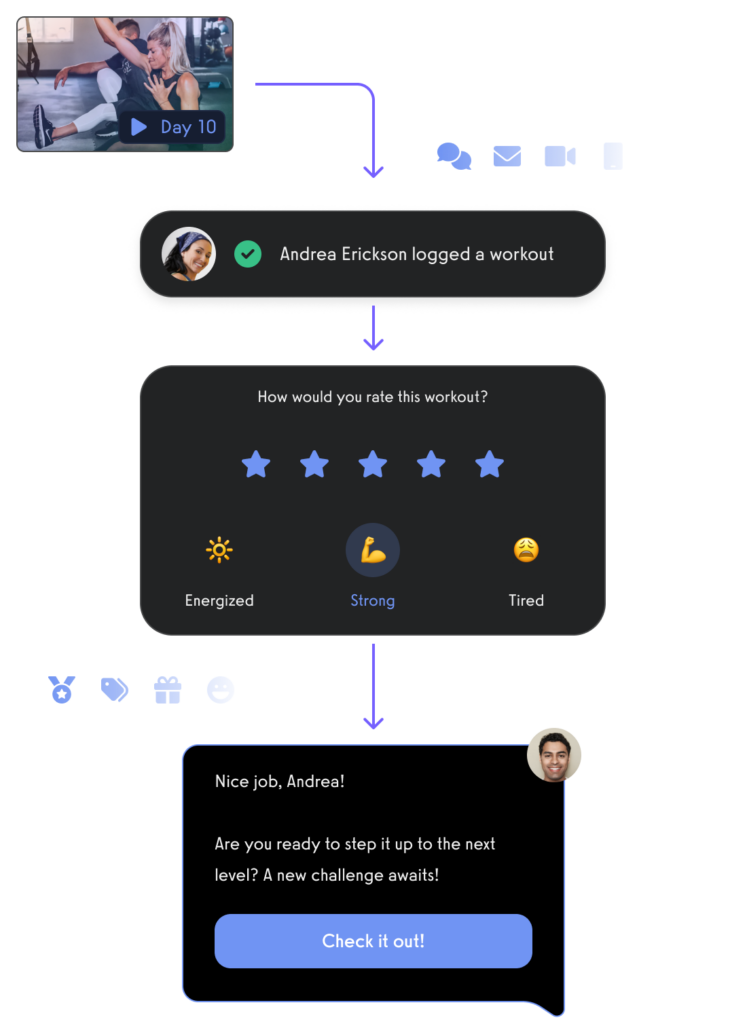
Manage leads with a fitness CRM.

Create and send fitness assessments with ease.
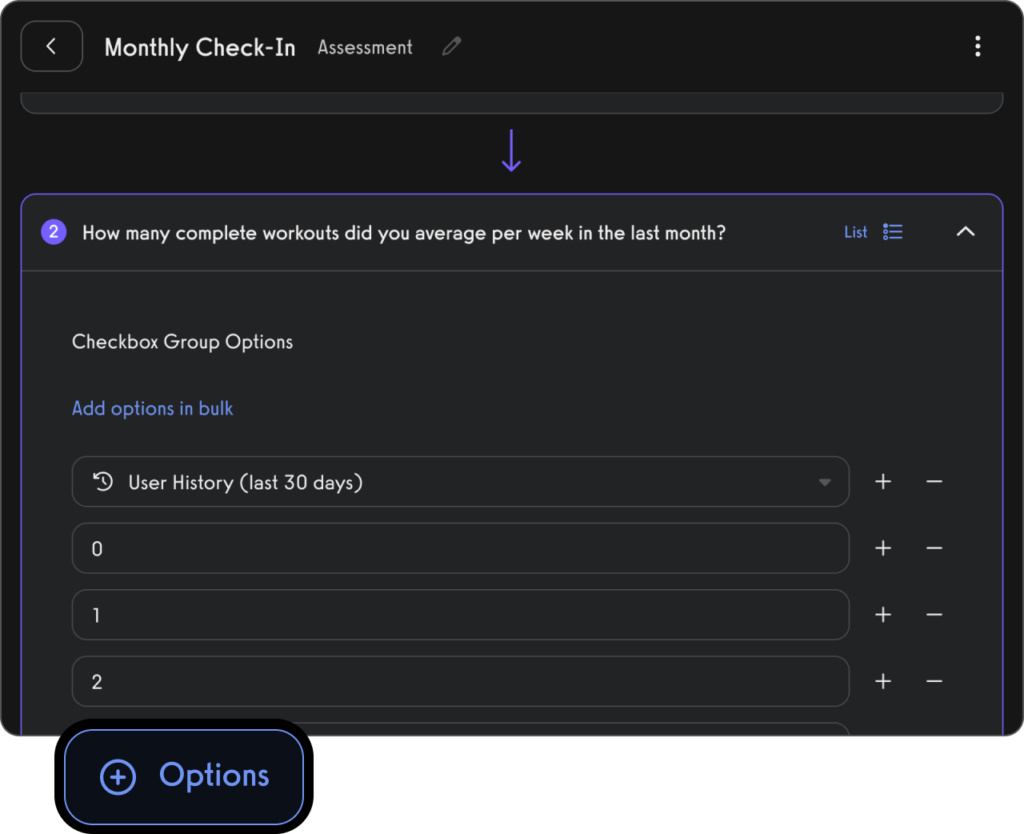
Use fitness habit tracking to inspire and motivate personal training clients (in-person and remote).

Use fitness progress photos to engage with clients.
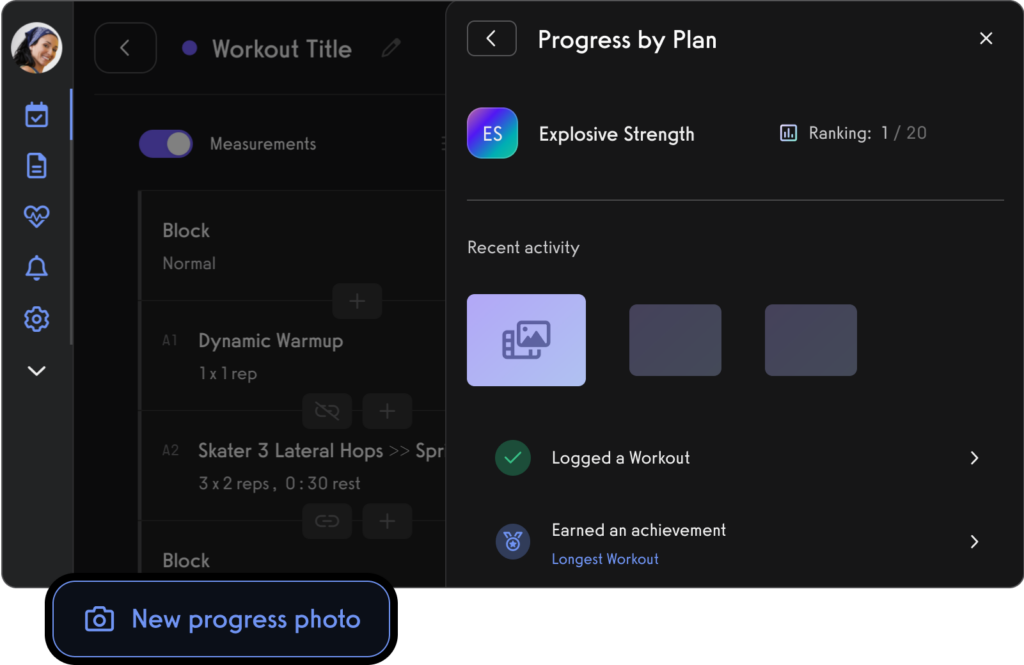
Use fitness leaderboards to track performance and inspire healthy competition.

Use the exercise demonstration video library or create your own custom exercise demonstration videos.
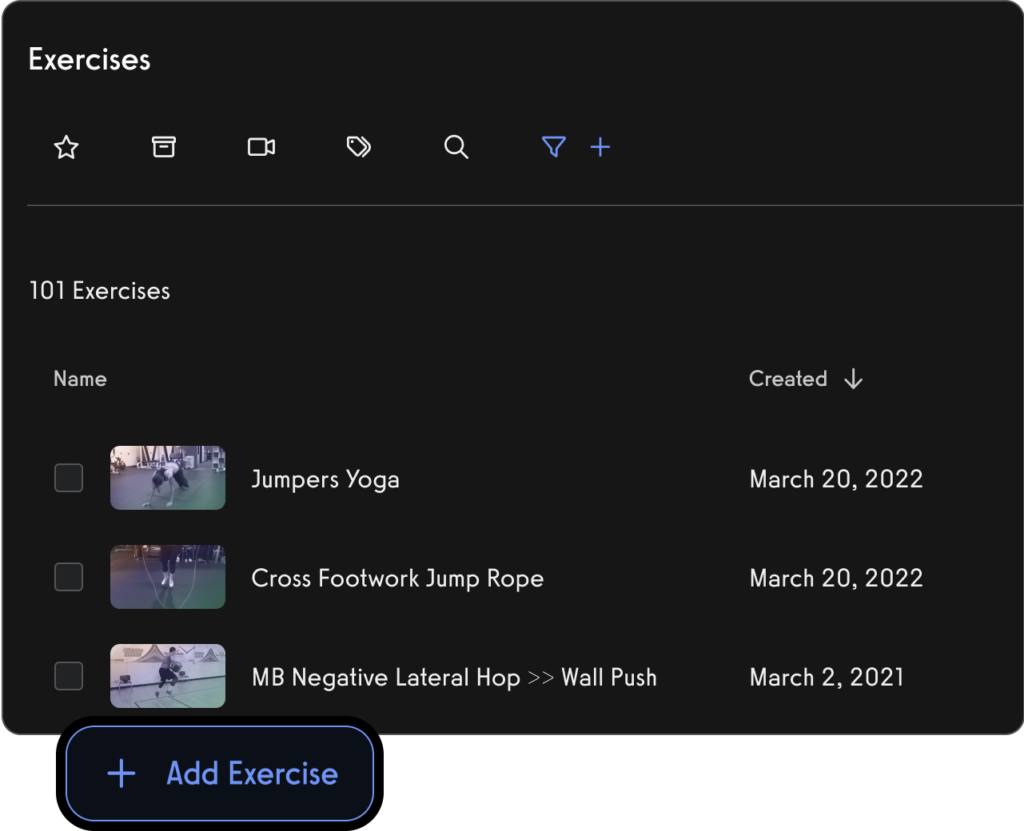
Create workout plans for parents and dependents, teams and more.

Manage personal training clients with ease.

Book appointments for clients (Read More: Best Gym Booking Software)

Create classes and fitness groups

Manage fitness challenges (Read More: 100+ Fitness Challenge Ideas)
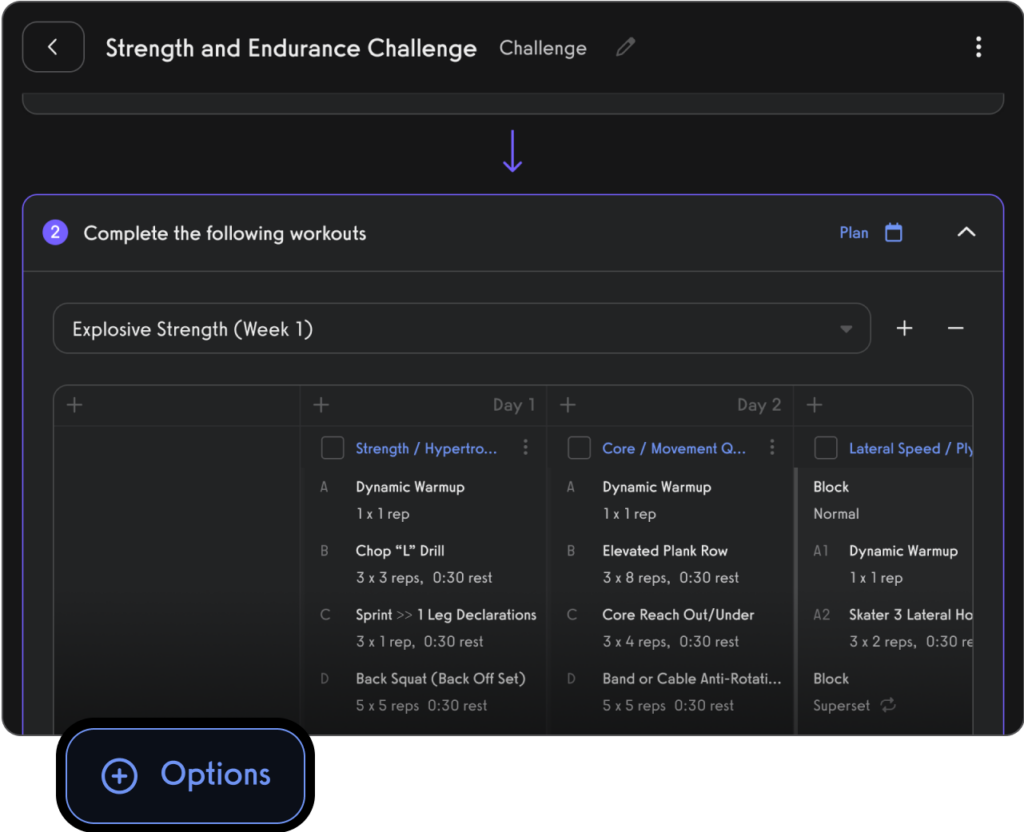
Process payments for open gym, classes, and personal training.

Communicate with gym members, athletes, team members, personal training clients, class members, parents, and dependents via SMS, email, and in-app push notification.

View performance over time, track personal records, and other fitness stats with performance reporting dashboards.

And of course, view all of your fitness business reports easily too.

All from your custom-branded fitness apps (Read More: Best Gym Mobile Fitness Apps Software)


Want to learn how your fitness business can take it to the next level? Get a demo now!









